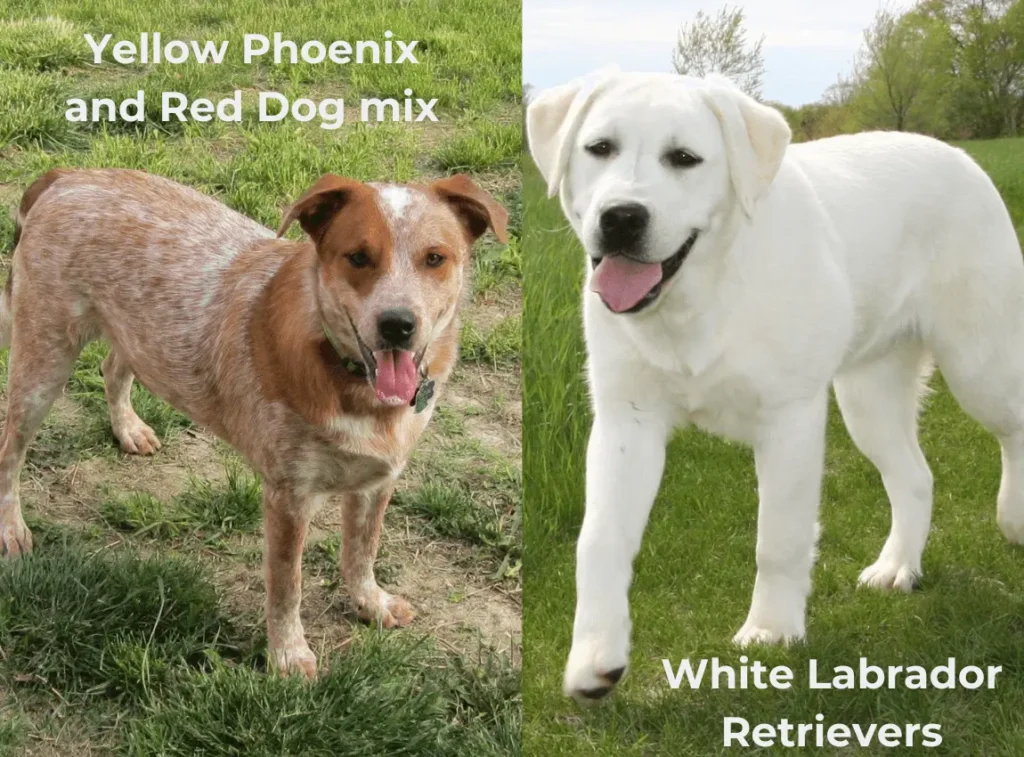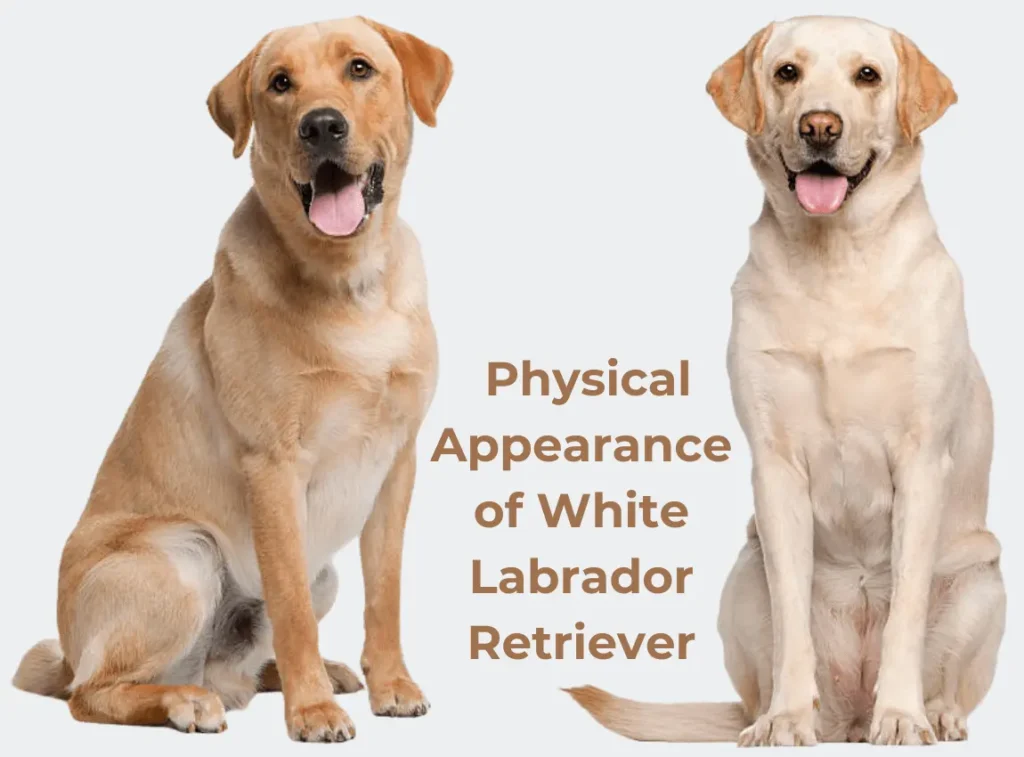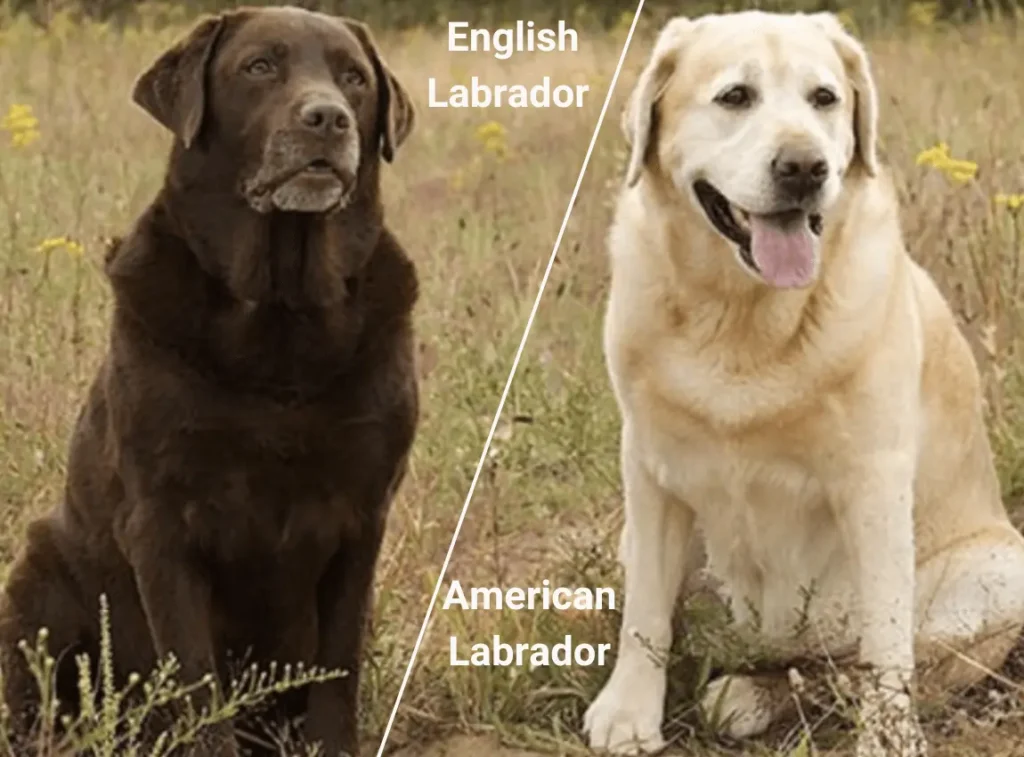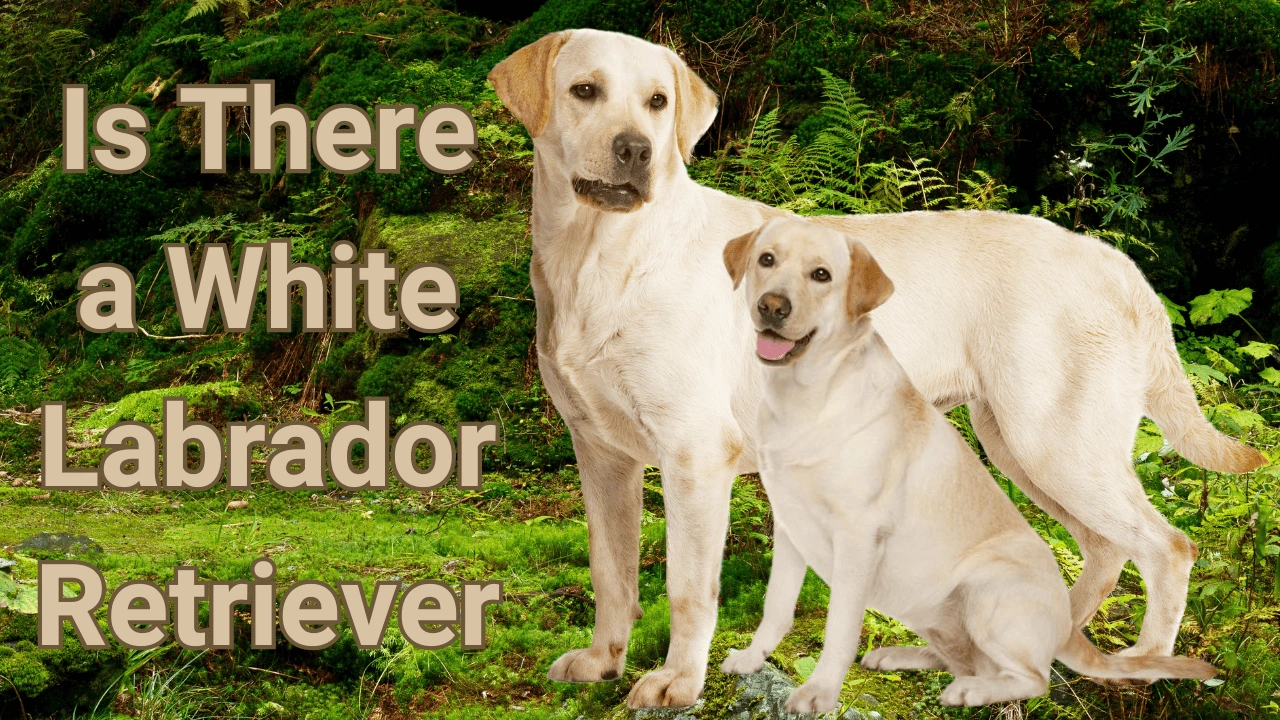White Labrador Retrievers are a type of white Labrador often mistaken for their own distinct color. Although these dogs do not come in true white they can be found as pale cream or off-White with lighter coat colors ranging from almost white to very light yellow.
The coloration results from combining genes responsible for the Yellow Phoenix and Red Dog mix. White Labradors are generally considered friendly, loyal, and intelligent pets that share many traits with other breeds.
However, they stand out from others due to their striking appearance like all Labradors White is known for being an excellent family pet or service dog. Particularly ideal when used as a work dog in settings wielded by chauffeured Service Dogs or therapy horses.

White Labrador Retrievers are a calm and playful breed that is well-suited for homes with children or other pets. However, their coat may still require regular washing appointments to maintain their health. They prefer activities in areas where physical activity levels remain high.
- History of the White Labrador Retrievers Dog Breed:
- Understanding Labrador Retriever Colors:
- Physical Appearance of White Labrador Retriever:
- The Genetics Behind Labrador Coat Colors:
- Difference between American and English Labradors Retrievers:
- Bio Overview of American Labrador and English Labrador Retrievers:
- Are White Labradors Recognized by Breed Standards:
- Personality and Characteristics of “White” Labradors:
- Ethical Considerations for Breeders and Buyers:
- Caring for White Labradors:
- Conclusion:
- Frequently Asked Question:
History of the White Labrador Retrievers Dog Breed:
The White Labrador Retriever is a variation of the traditional Lab which is white with ivory or light blue. White Labrador puppies were imported by British nobles and became a popular breed in England.
The white coloration is not an independent characteristic. But arises from the selective breeding of yellow Labrador Retriever dogs with varying levels of lightness, warmth, or dark pigmentations.
As time passed they came to be considered unique pets that are both desirable as family companions and working horses. Their intelligence and friendly nature complement each other well over half the dog’s lifespan.
Understanding Labrador Retriever Colors:
Labrador Retrievers are a highly sought-after breed worldwide that is known for their friendly personalities, intelligence, and versatility. They come in three commonly used colors: black, white, brown, gray, yellow, blue, red, orange, one by One or two.

- Black
- Chocolate
- Yellow
White Labradors are not a unique breed but rather part of the black or yellow color spectrum. Their coat can be as intense or fiery red as it is in this photo and may even appear white in some cases.
Color Spectrum of Yellow Labradors:
| Shade | Description |
| Fox-Red | Deep, reddish-gold tone |
| Golden Yellow | Classic yellow Labrador shade |
| Pale Cream | Lightest shade, often called “white” |
Physical Appearance of White Labrador Retriever:
The White Labrador Retriever is a striking white crossbreed dog breed that closely mimics the classic Lambretta. It can be trained to blend in with its American counterpart and become more socially active than its male equivalent.
But Labradors may not always belong on this list due to being naturally light-colored like Yellow Labrador. This retriever mixes into other litter as well without any accompanying photos or videos of individuals outside it.

Coat and Color: Colors of Black, Grey or Tan:
White Labrador Retrievers have a creamy white coat that is soft, dense, and waterproof. The double coating on the dog’s outer layer provides some protection against weather conditions while its undercoat can be thicker and more comfortable to wear.
Although not always pure white. It has subtle yellow or cream accents in areas around the ears and back.
Size and Build: How big or small are sizes:
White Labradors share physical characteristics with their counterparts in other Labrador breeds. They are medium to large and can measure anywhere from 22.5 inches (5.1 mm) at the shoulder. Male dogs typically stand between 220.5-65.4 cm (14.5-41.4 Inch).
Females usually weigh around 55-70 pounds or less but tend to be smaller than white Hunde who have been raised over pet years.
Labradors have a muscular and well-balanced body that gives them an athletic appearance. Their broad chest, strong neckline, and powerful frame reflect their past as working dogs. Who also work to retrieve people or cats from the yard.
Facial Features or Factors: Can Be Seen With A Smoother Skin Surface:
The White Labrador is a coat that has ear flaps but they are not very active. They have rounded heads and eye fur. Their eyes often appear almond-shaped while the white parts contain honeydew seeds or sephorum extractor (Algorumpus usus) Extractive.
These dogs usually carry around 5-6 inches in length when fully reared to avoid offsetting them with direct contact for approximately 3-4 minutes on each leg (5-4 inches).
Tail and Paw: Tail and Collision & Fur Coat’s Paw:
Labradors are known for their swimming ability which is enhanced by a thick and dense “otter tail” that tapers at the base towards the tip. This tail also aids in feeding other dogs with fur as they can swim very well using webbed paws.
Dog lovers are fond of the White Labrador Retriever which combines elegance and strength in an adorable hybrid that looks like it belongs on its own.
The Genetics Behind Labrador Coat Colors:
The Labrador’s coat color is determined by a few genes but without getting into specificity. The base color of this particular breed comes from two main genetic factors B and E. While other modifiers can make or break it. They don’t necessarily determine the overall shade.
There are three basic gene expression modifications for each to play an important role in modern Labrador life. That began with Down syndrome on September 9, 2009. Labradors with a single “black gene” will typically have a black coat as the dominant color is black.
White and yellow Labradors have two genes containing the “E” gene which is recessive. However, their genetic makeup determines how much of an animal’s coat. It will be color-blind (or possibly blue) and can produce different shades depending on other factors.
White Labradors have a “pale cream” color due to genetic combinations that reduce the amount of fur in their coat. The skin and nose may retain darker hues but the overall appearance is almost white.
Difference between American and English Labradors Retrievers:
The Labrador Retriever is a popular dog breed that’s both friendly and playful. Although there are two primary classifications of this pet Labrador retrievers. American and English display significant differences in appearance, temperament and use while still being members of the same family.

However, several may appear different due to their dual roles as protector dogs from various countries around the world.
Appearances on Display:
The physical traits of American Labradors are not too different from those found in English Labradors in the nation. Rather they have a taller and lean build with fewer feathers than the European Labrador breed. That is more commonly associated with mitigating crossbreeds.
Which tend to be narrowly chartered and exhibit longer legs for outdoor activities due to their extensive genetic development. English Labradors have a wider, stocky build with rounded shoulders and a thicker neckline. They are also more compact than American Pit Bull Terriers.
They prefer to show off their full body for strength instead of being larger or weaker in winter when harnessed on warm days. This is the ideal physical condition for showing dogs that want to exhibit their natural form.
Temperament:
Temperament is a term used to describe the process of tempering. Both Labradors and American Labrador are known for their friendly, loyal, and good-natured personalities. However, there is some variation in temperament between these dogs due to breeding.
The former tend to be more energetic than the other (especially the German Shepherd and white English Pit Bull breed) working hard during field trials or hunting activities.
English Labradors despite their energy levels and temperament are typically more composed and unhurried. They tend to be the most social dogs possible making them ideal as family dogs. They can also function well in various settings such as therapy dogs or show animals etc.
Purpose and Training:
The American Labrador was trained specifically for fieldwork excelling in hunting and retrieving tasks. Their high drive and quick reflexes make them well-suited to these activities. However, they may require more structured training to maintain their engagement beyond a routine interval or two during rigorous outdoor work events
English Labradors are typically bred for obedience and show-ready behavior in the ring. Where their training may prioritize learning commands or stay composed when exercising.
Health Canada (HPSC):
Labrador Retrievers and American Labrador puppies share similar health concerns such as obesity and hip dysplasia. However, compared to English white Labrador Retrievers who are heavier in weight than their male counterparts the former is more likely to experience joint problems that can be related to weight or arthritis.
Bio Overview of American Labrador and English Labrador Retrievers:
| Aspect | American Labrador Retriever | English Labrador Retriever |
| Body Build | Lean, athletic, and taller. | Sturdy, stocky, and broader. |
| Head Shape | Narrower skull, longer muzzle. | Broader skull, shorter muzzle. |
| Coat | Slightly thinner, less dense. | Dense, thick double coat. |
| Temperament | High-energy, active, and focused on tasks. | Calm, easygoing, and relaxed. |
| Purpose | Bred for fieldwork, hunting, and performance. | Bred for conformation shows and companionship. |
| Training Style | Responds well to high-intensity, task-driven training. | Responds well to gentle, consistent training. |
| Size | Males: 21.5–24.5 in (55–62 cm); 65–80 lbs (29–36 kg). | Males: 21.5–22.5 in (55–57 cm); 65–80 lbs (29–36 kg). |
| Activity Level | Very high; needs daily physical and mental stimulation. | Moderate; enjoys regular walks and playtime. |
| Appearance | Sleek, athletic look suitable for performance. | Robust, classic appearance suitable for showing. |
| Common Use | Hunting, field trials, and agility competitions. | Family pet, therapy dog, and show dog. |
Are White Labradors Recognized by Breed Standards:
White Labradors are not the only dog breed as they can have a range of colors from bright red to dark blue. The American Kennel Club (AKC) states that white Labrador is an extremely light version of yellow and falls within this category because it’s just one shade below their natural coloration.
White Labradors are not a distinct breed and can be classified as such. They’re simply variations of the yellow coat which is why they have their white fur family members.
Personality and Characteristics of “White” Labradors:
White Labradors are just like any other Labrador dog and have the same charming personality:

- They are friendly towards both humans and other animals.
- Labradors are quick learners. They make excellent service pets because of their intelligence.
- Labradors, like all other breeds of dogs in this condition, require a lot more exercise and mental stimulation.
The coat color of a Labrador is often misunderstood as an indicator or attribute for personality traits. However, I have found that the temperament of Labrador is more directly related to their upbringing (throughout human-pet studies), training and genetic makeup. It is also to be determined by color alone.
Ethical Considerations for Breeders and Buyers:
When selecting a reliable breeder to obtain white Labradors, it is important to consider the reputation and transparency of the individual. Some breeders may advertise their lab coat as “rare” and charge exorbitant prices which contradicts what other colors like blue or yellow are just shades added on by humans.
Tips for Choosing a Breeder:
- Labrador breeds often suffer from several health conditions such as hip dysplasia and progressive retinal atrophy. This is why the veterinarian will conduct health screenings for them.
- Breeders who prioritize coat color over health and temperament should be avoided.
- View the puppy’s home to gain insight into how they are raised.
If you’re considering adopting a Labrador reach out to rescue groups that specialize in finding suitable pets. A pale yellow or white labradoodle could be an ideal match for adoption.
Caring for White Labradors:
White Labradors require special attention to be properly cared for. Although they’re relatively easy on the coat and have a light coloration. However, their fur can pose challenges when left unattended in various areas of the hereditary home.

Grooming Tips:
- Regular Brushing: Regularly brushing with a softener to remove loose fur and minimize hair loss.
- Bathing: Avoid over-bathing and wash your skin as this can dry them out.
- Sun Protection: Dogs with lighter fur can experience sunburn especially in their lean areas like the nose and ears. If you’re going out in public for extended periods make sure to use appropriate pet sunscreen as well.
Health Considerations:
Labradors are generally well-behaved but like all breeds they tend to develop certain ailments.
- Labradors often suffer from hip and elbow dysplasia which can cause joint problems. Maintain a healthy weight to reduce the strain on these joints.
- Regular eye exams can help identify issues like cataracts and other similar problems early on.
- White Labradors are more easily tamed and may require regular brushing to keep them clean.
Also Read: https://thepetlive.com/siberian-huskies-color-have-black-and-white/
Conclusion:
Although there is no official “white Labrador Retriever” breed, some Labradors appear white due to their light yellow coat and are often referred to as “white” Labradors. This white color is the result of certain genetic factors that affect coat color but does not represent a separate breed or variety within the Labrador Retriever species.
Whether you are interested in the Labrador as a loyal companion or an excellent working dog the breed’s friendly nature, intelligence, and versatility make it an ideal choice for many dog lovers.
If you are looking for a Labrador with a light-colored coat it is important to choose a reputable breeder who adheres to ethical breeding practices to ensure you get a healthy, sociable dog. Regardless of coat color all Labrador Retrievers are loving and loyal pets.
Frequently Asked Question:
Is a white Labrador Retriever rare?
White Labradors which are light yellow Labradors with a pale coat and often lack white fur may be less common but not uncommon.
What is the rarest color for a Labrador?
Chocolate or silver are the two most frequently found colors in Labradors but their exacting nature and breeding dogs practices may vary.
Can purebred Labs have white?
Purebred Labradors can have a pale yellow coat that appears white but meets breed requirements.
What is the price of a white Labrador?
White Labrador prices can range from $1,000 to $3,000 depending on location, breeder reputation and lineage.
What is the lifespan of a white Labrador?
Like other Labradors a white Labrador can live up to 10 or 12 years.
What is the personality of a white Lab?
White Labs are a great companion, thanks to their friendly, intelligent and outgoing personalities.
What is the most common cause of death in Labradors?
Cancer is the leading cause of death in Labradors and it has been found that cancer causes most deaths among Labradors as pets.
Which color Labrador lives the longest?
Genetic health factors may be the reason why yellow and black Labradors have a longer lifespan than chocolate Labradors but they usually only live up to half their lifetime.










